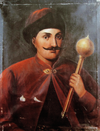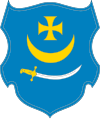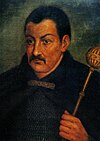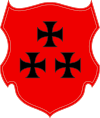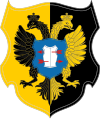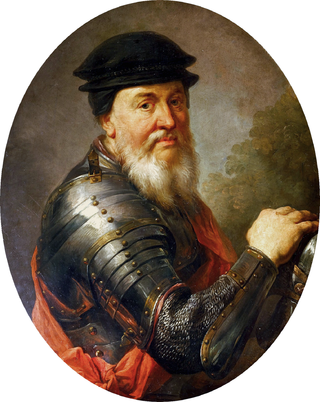
Hetman is a political title from Central and Eastern Europe, historically assigned to military commanders. Used by the Czechs in Bohemia since the 15th century, it was the title of the second-highest military commander after the king in the Crown of the Kingdom of Poland and the Grand Duchy of Lithuania from the 16th to 18th centuries. Throughout much of the history of Romania and the Moldavia, hetmans were the second-highest army rank. In the modern Czech Republic, the title is used for regional governors.

The Pereiaslav Agreement or Pereyaslav Agreement was an official meeting that convened for a ceremonial pledge of allegiance by Cossacks to the Tsar of Russia in the town of Pereiaslav, in central Ukraine, in January 1654. The ceremony took place concurrently with ongoing negotiations that started on the initiative of Hetman Bohdan Khmelnytsky to address the issue of the Cossack Hetmanate with the ongoing Khmelnytsky Uprising against the Polish–Lithuanian Commonwealth and which concluded the Treaty of Pereiaslav. The treaty itself was finalized in Moscow in April 1654.

Ivan Stepanovych Mazepa was a Ukrainian military, political, and civic leader who served as the Hetman of the Zaporizhian Host and the Left-bank Ukraine in 1687–1708. The historical events of Mazepa's life have inspired many literary, artistic and musical works. He was famous as a patron of the arts.

The bulava or buława is a ceremonial mace or baton or sceptre.
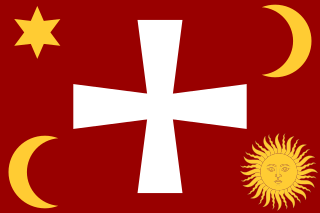
The Zaporozhian Sich was a semi-autonomous polity and proto-state of Cossacks that existed between the 16th to 18th centuries, including as an autonomous stratocratic state within the Cossack Hetmanate for over a hundred years, centred around the region now home to the Kakhovka Reservoir and spanning the lower Dnieper river in Ukraine. In different periods the area came under the sovereignty of the Polish–Lithuanian Commonwealth, the Ottoman Empire, the Tsardom of Russia, and the Russian Empire.

Ivan Vyhovsky, a Ukrainian military and political figure and statesman, served as hetman of the Zaporizhian Host and of the Cossack Hetmanate for three years (1657–1659) during the Russo-Polish War (1654–1667). He succeeded the famous hetman and rebel leader Bohdan Khmelnytsky. His time as hetman was characterized by his generally pro-Polish policies, which led to his defeat by pro-Russian elements among the Cossacks.

Registered Cossacks comprised special Cossack units of the Polish–Lithuanian Commonwealth army in the 16th and 17th centuries.
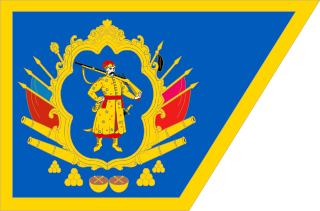
The Cossack Hetmanate, officially the Zaporozhian Host or Army of Zaporozhia, is a historical term for the 17th-18th centuries Ukrainian Cossack state located in central Ukraine. It existed between 1649 and 1764, although its administrative-judicial system persisted until 1782.
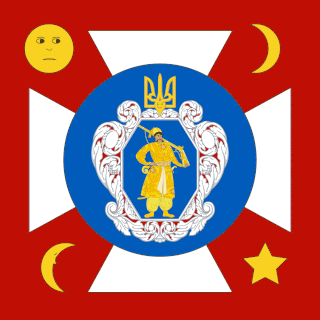
The Hetman of all Ukraine was the head of state and commander-in-chief of the Ukrainian State in 1918.
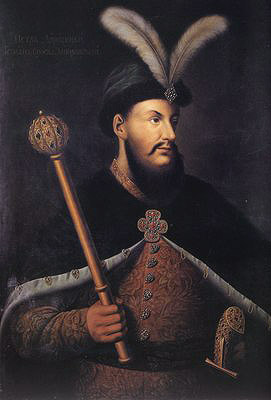
Petro Dorofiyovich Doroshenko was a Cossack political and military leader, Hetman of Right-bank Ukraine (1665–1672) and a Russian voivode.

The Ruin is a historical term introduced by the Cossack chronicle writer Samiilo Velychko (1670–1728) for the political situation in Ukrainian history during the second half of the 17th century.
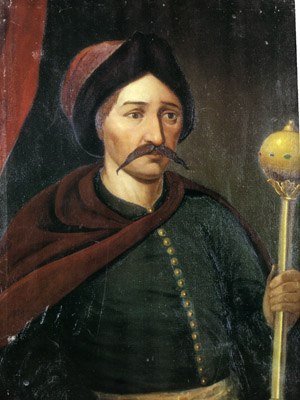
Pavlo Teteria was Hetman of Right-bank Ukraine (1663–1665). His real name is Pavlo Morzhkovsky. Before his hetmancy he served in a number of high positions under Bohdan Khmelnytsky, and Ivan Vyhovsky.
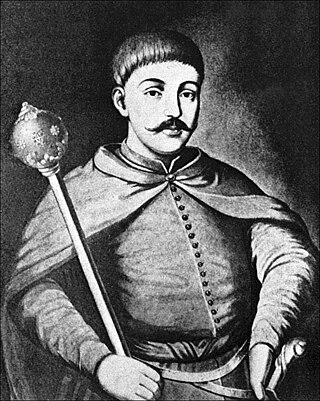
Ivan Briukhovetsky was a hetman of Left-bank Ukraine from 1663 to 1668. In the early years of rule his was positioned as pro-Russian policies incited a rebellion which he later joined in an attempt to salvage his reputation and authority. Later leader of the Anti-Moscow uprising. His assessments as a rule differ in the part of Ukrainian historians which are supporters Petro Doroshenko.
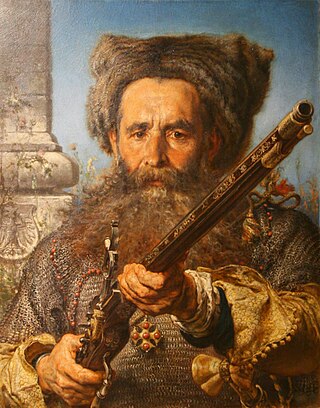
Ostap Dashkevych is considered to be the first recorded leader of a Cossack defense force. However that claim of "first" is debatable because there were many other early leaders, including Bohdan Glinski from Severia and Dmytro Vyshnevetsky.
Acting hetman or appointed hetman was a title during the 17th and 18th centuries in the Cossack Hetmanate. The acting hetman was the governing authority in the Cossack Hetmanate temporarily substituted for the Hetman.

The Chyhyryn Regiment was one of the seventeen territorial-administrative subdivisions of the Hetman State. The regiment's capital was the city of Chyhyryn, now in the Cherkasy Oblast of central Ukraine. The military units of the regiment were also known as the Hetman's Guard serving as personal guards of the Hetman of Ukraine in 1648–1676.

Ottoman Ukraine, Khan Ukraine, Hanshchyna is a historical term for right-bank Ukraine, also known by its Turkic name Yedisan. The first recorded use of the term Khanska Ukraina are traced to 1737 when the Russian secret-agent Lupul urged Empress Anna of Russia to attack Ottoman Ukraine.

The Hetman of the Zaporizhian Host was the head of state of the Cossack Hetmanate in what is now Ukraine. The office was disestablished by the Russian government in 1764.
The Little Russia Office was a Muscovite state agency (Prikaz) and administrative body of the Tsardom of Muscovy in charge of affairs connected with the Cossack Hetmanate and the Left-bank Ukraine. Created on 10 January 1663 [O.S. 31 December 1662], the office existed until 1722 when it was transformed into the Collegium of Little Russia and moved to Hlukhiv. The Little Russia Office was part of the bigger Ambassadorial Office and since 1671 was chaired by the head of the office.

Kost Hordiienko was a Zaporozhian Cossack Kish otaman. After 1709 he allied with Ivan Mazepa, and co-authored the Constitution of Pylyp Orlyk.




